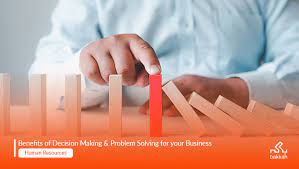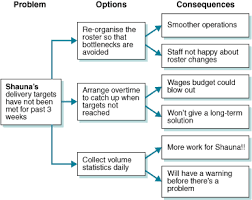Brainstorming: An Effective Problem-Solving and Decision-Making Technique
When faced with a problem or a decision to make, it can often feel overwhelming and challenging to find the best solution. This is where brainstorming comes in—an effective technique that helps generate creative ideas, fosters collaboration, and ultimately leads to better problem-solving and decision-making outcomes.
So, what exactly is brainstorming? In simple terms, it is a group or individual activity that encourages the free flow of ideas without judgment or criticism. By creating an open and non-judgmental environment, brainstorming allows individuals to explore different perspectives and think outside the box.
One of the key benefits of brainstorming is its ability to generate a wide range of ideas. When people come together and share their thoughts without fear of criticism, it opens up opportunities for unique and innovative solutions. Each idea builds upon the previous ones, leading to a rich pool of possibilities.
Moreover, brainstorming promotes collaboration among team members. It encourages active participation from everyone involved, ensuring that each person has an equal opportunity to contribute their ideas. This inclusivity fosters a sense of ownership and collective responsibility towards finding the best solution.
During a brainstorming session, no idea should be dismissed or judged prematurely. The focus should be on quantity rather than quality in the initial stages. By suspending judgment, individuals are free to explore even seemingly wild or unconventional ideas. Sometimes, these seemingly outlandish suggestions can spark unexpected breakthroughs or inspire more practical solutions.
To make the most out of a brainstorming session, it’s important to establish some ground rules:
- Encourage active participation: Create an inclusive environment where everyone feels comfortable sharing their thoughts and opinions.
- Embrace diversity: Welcome diverse perspectives as they can lead to more comprehensive and well-rounded solutions.
- Avoid criticism: Suspend judgment during the idea generation phase; all ideas are valid at this stage.
- Build upon ideas: Encourage participants to build upon each other’s ideas, fostering collaboration and creativity.
- Set a time limit: To keep the session focused and efficient, establish a time limit for idea generation.
Once the brainstorming session is complete and a large number of ideas have been generated, the next step is to evaluate and refine them. This involves analyzing each idea based on its feasibility, potential impact, and alignment with the desired outcome. By applying critical thinking and considering practical constraints, the pool of ideas can be narrowed down to a few viable options.
Brainstorming is not restricted to group settings; it can also be an effective technique for individual decision-making. By creating a personal brainstorming space and following the same principles, individuals can explore different possibilities and weigh their options more effectively.
In conclusion, brainstorming is a powerful problem-solving and decision-making technique that encourages creativity, collaboration, and innovative thinking. By embracing diverse perspectives, suspending judgment, and fostering an inclusive environment, individuals or teams can unlock their collective potential to find optimal solutions. So why not give brainstorming a try? You might be surprised at the incredible ideas you’ll uncover along the way!
Frequently Asked Questions about Brainstorming as a Problem Solving and Decision Making Technique
- What are 3 benefits of brainstorming?
- How can brainstorming help in the decision making process?
- What is an example of a brainstorming technique?
- What are the 4 methods of brainstorming?
What are 3 benefits of brainstorming?
- Increased Creativity: One of the primary benefits of brainstorming is its ability to foster creativity. By encouraging the free flow of ideas without judgment or criticism, brainstorming allows individuals to think outside the box and explore unconventional solutions. This open-minded approach often leads to innovative and creative ideas that may not have been generated through traditional problem-solving methods.
- Collaboration and Team Building: Brainstorming promotes collaboration among team members, creating a sense of unity and shared ownership. When everyone has an equal opportunity to contribute their ideas, it fosters a positive team dynamic and encourages active participation. Collaborative brainstorming sessions can strengthen relationships, improve communication, and enhance overall teamwork.
- Diverse Perspectives: Another significant benefit of brainstorming is the inclusion of diverse perspectives. When individuals from different backgrounds, experiences, and expertise come together to brainstorm, it brings a variety of viewpoints to the table. This diversity sparks fresh insights and alternative approaches that may not have been considered otherwise. By embracing these diverse perspectives, brainstorming expands the range of possible solutions and increases the likelihood of finding the most effective one.
Overall, brainstorming offers benefits such as increased creativity, collaboration among team members, and the inclusion of diverse perspectives. By leveraging these advantages, individuals and teams can enhance problem-solving abilities and make more informed decisions.
How can brainstorming help in the decision making process?
Brainstorming plays a crucial role in the decision-making process by providing a structured approach to generate ideas and explore different possibilities. Here are some ways in which brainstorming can help in decision making:
- Idea Generation: Brainstorming allows for the generation of a wide range of ideas related to a specific problem or decision. By encouraging participants to think freely and without judgment, brainstorming helps uncover innovative and creative solutions that may not have been considered otherwise.
- Diverse Perspectives: Brainstorming brings together individuals with different backgrounds, expertise, and viewpoints. This diversity of perspectives enriches the decision-making process by offering varied insights and approaches to tackle the problem at hand. It helps avoid narrow thinking and encourages holistic consideration of all factors involved.
- Collaboration and Teamwork: Brainstorming fosters collaboration among team members or decision-makers. It creates an environment where everyone has an equal opportunity to contribute their thoughts and ideas, promoting teamwork and collective ownership of the decision-making process. Collaboration often leads to more informed decisions as it leverages the collective intelligence of the group.
- Overcoming Mental Blocks: In complex decision-making situations, individuals may face mental blocks or be limited by their own biases or preconceived notions. Brainstorming breaks through these barriers by encouraging participants to think outside the box, challenge assumptions, and explore unconventional ideas. It helps overcome cognitive biases that may hinder effective decision making.
- Evaluation and Selection: After generating a pool of ideas through brainstorming, the next step is evaluating and selecting the most promising options for further consideration. By critically analyzing each idea based on its feasibility, potential impact, risks involved, and alignment with desired outcomes, brainstorming enables a systematic evaluation process that leads to informed decisions.
- Enhanced Creativity: Brainstorming stimulates creativity by creating an environment where participants are encouraged to think imaginatively and propose novel solutions. The free flow of ideas during brainstorming sessions often sparks new insights, connections, and perspectives that can lead to breakthrough solutions or innovative approaches to decision making.
- Increased Engagement and Ownership: By involving individuals in the decision-making process through brainstorming, it increases their engagement and sense of ownership. When people feel that their ideas are valued and taken into consideration, they become more invested in the final decision’s success and are more likely to support its implementation.
In summary, brainstorming enhances the decision-making process by facilitating idea generation, fostering collaboration, overcoming mental blocks, promoting diverse perspectives, enabling systematic evaluation, stimulating creativity, and increasing engagement. By incorporating brainstorming techniques into the decision-making process, individuals and teams can make more informed and effective decisions.
What is an example of a brainstorming technique?
One example of a brainstorming technique is the “Mind Mapping” method. Mind mapping is a visual brainstorming technique that helps organize and explore ideas in a structured manner. Here’s how it works:
- Start with a central idea: Write down the main problem or decision you’re trying to address in the center of a blank page or whiteboard.
- Branch out: From the central idea, create branches radiating outward like a tree. Each branch represents a different category or aspect related to the main idea.
- Generate sub-branches: On each branch, jot down related sub-ideas or factors that contribute to the main category. These sub-branches can be connected to their respective branches.
- Expand further: Keep expanding each sub-branch by adding more specific ideas or details related to them. You can use colors, images, or symbols to visually represent different ideas and make your mind map more engaging.
- Make connections: Look for connections between different branches and sub-branches. Identify relationships, dependencies, or potential solutions that emerge from these connections.
- Explore new branches: If new ideas come up during the process, create additional branches off existing ones or add completely new branches to capture those ideas.
- Review and refine: Once you have exhausted your ideas and explored various aspects of the problem or decision, review your mind map as a whole. Identify the most promising ideas or solutions that stand out.
Mind mapping allows for nonlinear thinking and encourages creativity by visually representing thoughts and connections between them. It helps individuals or teams generate a multitude of ideas while providing a clear overview of how they relate to each other.
Remember, there are various other brainstorming techniques apart from mind mapping—such as reverse brainstorming, brainwriting, or SWOT analysis—each with its own unique approach to generating creative solutions and making decisions effectively based on specific needs and preferences.
What are the 4 methods of brainstorming?
There are several methods of brainstorming that can be used to stimulate creative thinking and generate a wide range of ideas. Here are four commonly used methods:
- Traditional Brainstorming: This is the most well-known and widely used method. In traditional brainstorming, a group of individuals gathers together and freely shares their ideas on a specific topic or problem. The focus is on quantity rather than quality, encouraging participants to generate as many ideas as possible without judgment or criticism. All ideas are recorded for later evaluation and refinement.
- Reverse Brainstorming: In reverse brainstorming, the goal is to identify potential causes or problems instead of solutions. Participants brainstorm ideas on how to create or exacerbate the problem at hand. By flipping the perspective, it helps uncover underlying issues that need to be addressed before finding appropriate solutions.
- Mind Mapping: Mind mapping is a visual brainstorming technique that involves creating a diagram or chart to explore connections between different ideas or concepts. It starts with a central idea in the center of the map, and then branches out into sub-ideas or related concepts. This method helps visualize relationships and associations, enabling participants to generate new ideas based on existing ones.
- Six Thinking Hats: Developed by Edward de Bono, the Six Thinking Hats method involves assigning different “thinking hats” to participants, each representing a different perspective or approach. For example, the white hat represents objective facts and information, while the green hat represents creative thinking and generating new ideas. By systematically switching between hats during a brainstorming session, participants can explore multiple angles and viewpoints.
These methods provide structure and guidance during brainstorming sessions, helping individuals or teams think more creatively and effectively generate innovative solutions. However, it’s important to remember that these techniques can be adapted and combined based on specific needs and preferences to maximize their effectiveness in problem-solving and decision-making processes.




